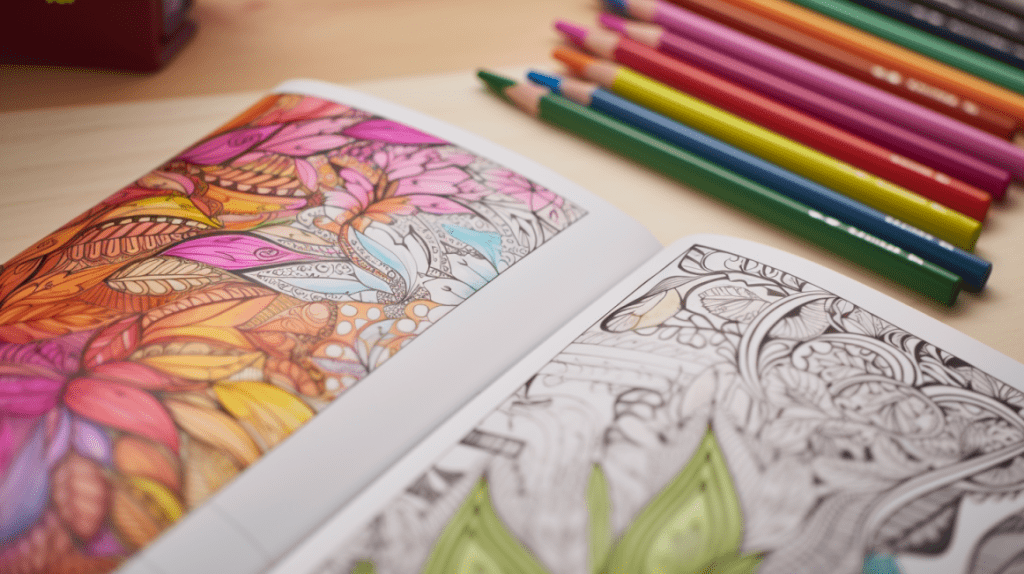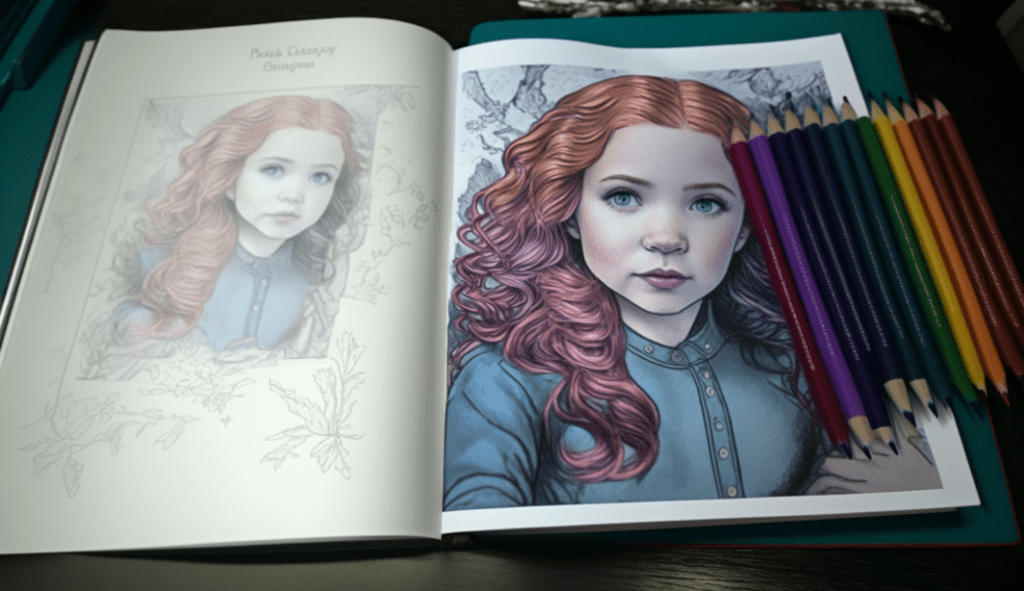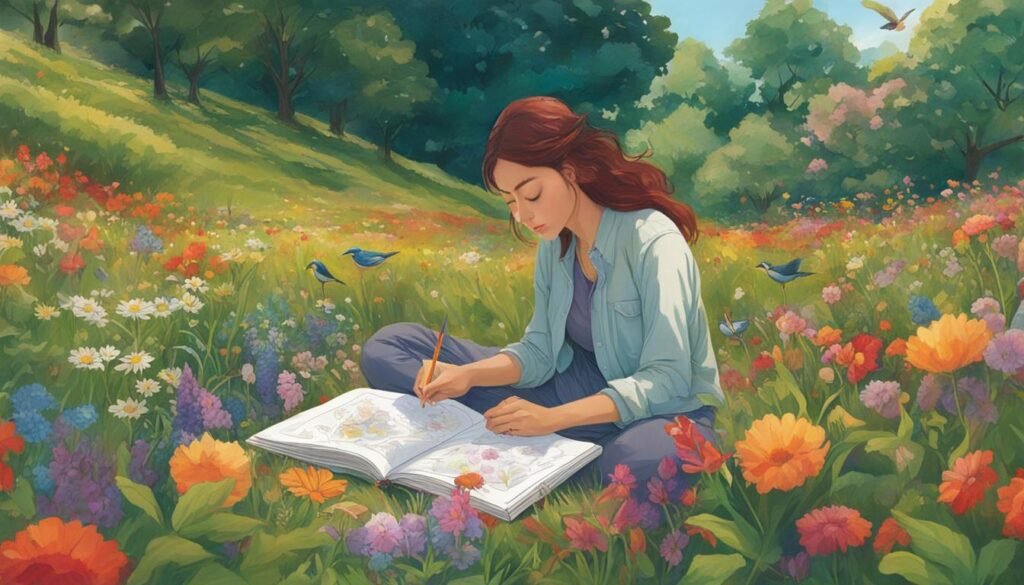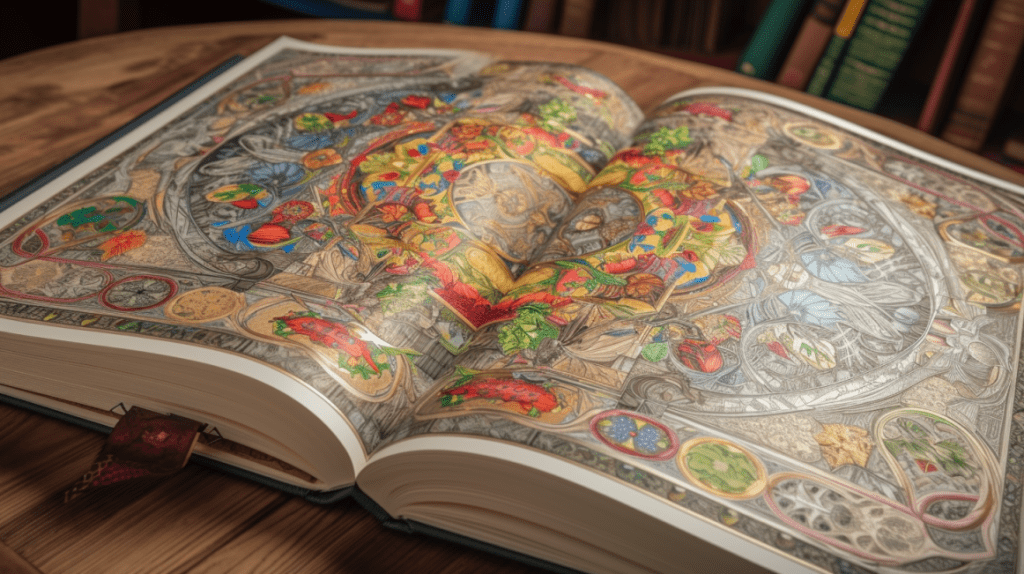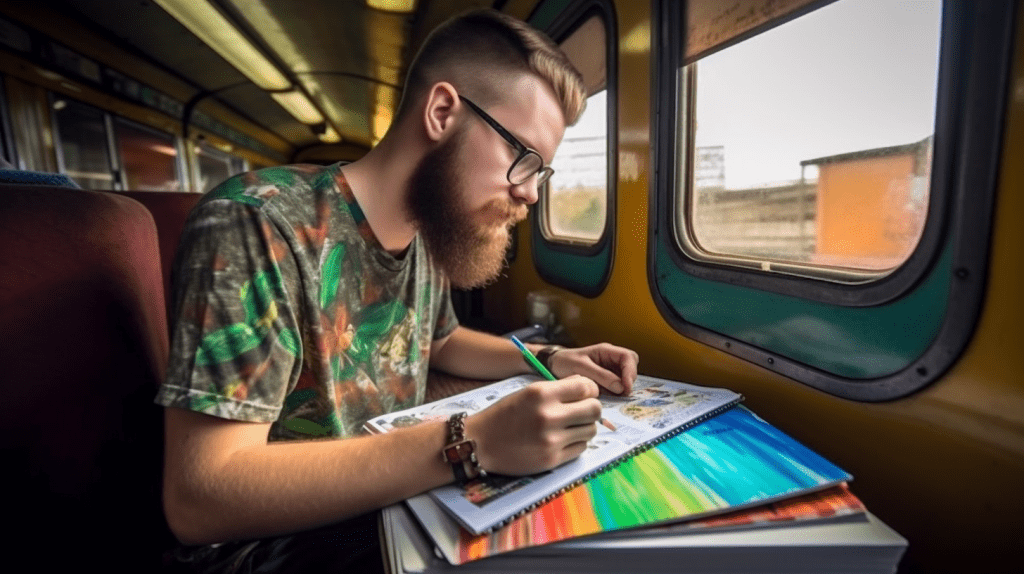Embarking on a journey to create an artistic oasis of your own? Look no further, as how to create a coloring book from scratch uncovers the process that brings vibrancy and satisfaction to hands worldwide. With the rise in popularity of adult coloring books and a **2017 study** highlighting their role in reducing stress and anxiety, there’s never been a better time to delve into coloring book creation tips. Crafting a bespoke coloring book isn’t just an expression of creativity; it’s an accessible venture that any enthusiast can undertake. This step by step coloring book tutorial will guide you through, ensuring each black and white page blossoms into a potential masterpiece waiting for a touch of color.
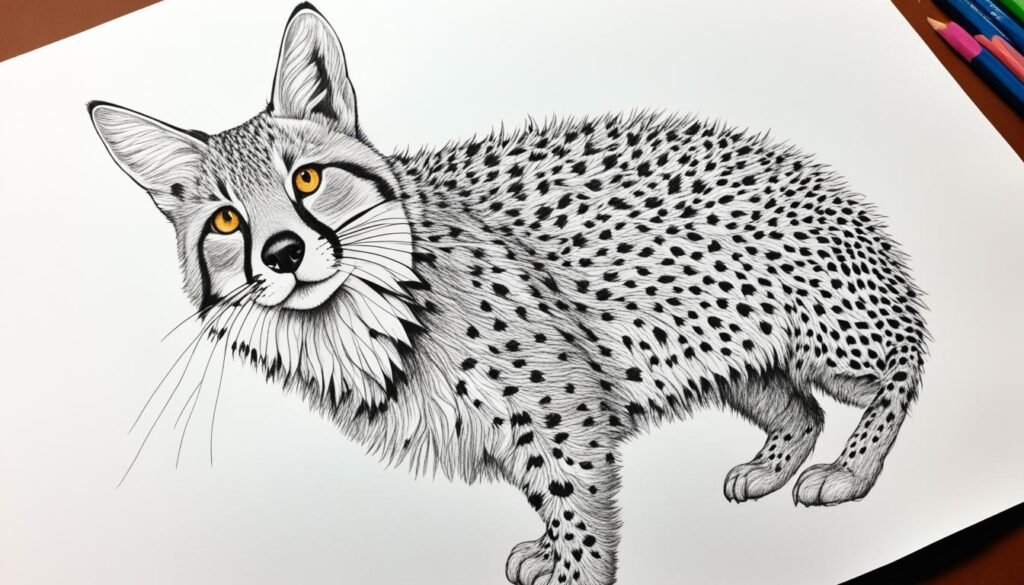
Key Takeaways
- Adult coloring books have far-reaching appeal, providing therapeutic benefits for stress relief.
- Establish the size and alignment of your coloring book for a cohesive look and seamless production.
- Choosing a resonant theme is key to personalizing and enhancing the coloring experience.
- Considering the coloring medium from the outset ensures the book accommodates different artistic tools.
- From design to binding, creating a coloring book is an enriching process that offers a rewarding creative outlet.
Understanding the Appeal of Coloring Books
The allure of adult coloring books transcends the vibrant hues and intricate patterns that dance across their pages. They embody a sanctuary for stress relief and have become an essential element in the toolkit of modern-day mindfulness practice. Coloring has quietly arisen as a soothing balm for the frazzled soul, drawing in everyone from harried professionals to royalty—yes, even figures like Kate Middleton have reportedly found solace within these paper-bound realms. But why do these monochromatic sketches beckon us so effectively?
At the root of their charm is the capacity of coloring books to facilitate a mental retreat, a place where concerns can dissipate, replaced by the rhythmic dance of color within predefined lines. For many, the act of coloring is not just a pastime; it is a form of active meditation. Each stroke of the crayon or marker serves as a gentle echo of the moment, grounding the artist in the present and allowing for a deeper connection with the self.
And yet, the rise of adult coloring books is more than a trend; it marks a recognition of the universal need for creative outlets that are not only accessible but also yield tangible benefits for mental health. The intricate designs found within these books do more than provide a canvas for expression; they offer a path to relaxation and tranquility, an escape that is as much about the process as it is the end result.
It’s no mystery that in our hyper-connected age, the simplicity and tactile pleasure of filling a drawing with color represent a digital detox, a welcomed respite from the relentless pace of screens and notifications. Coloring books invite us to slow down, to engage fully with the task at hand, and in doing so, provide a route back to ourselves.
| Benefits of Coloring | Details |
|---|---|
| Stress Reduction | Coloring can lower levels of cortisol, the “stress hormone,” promoting a more peaceful state of mind. |
| Mindful Engagement | By focusing on the present moment and action, coloring can be a form of mindfulness meditation. |
| Creative Exploration | Coloring provides a low-stakes environment for adults to explore and express their creative side. |
| Cognitive Improvement | The act of coloring utilizes areas of the brain involved in concentration and fine motor skills. |
The pages of a coloring book are a canvas for those seeking a pause in their daily lives. And as they traverse the stark lines and shapes, bringing them to life with each chosen pigment, a story emerges—not just of the image they’re creating, but of their own journey toward inner stillness and rejuvenation.
Initial Considerations for Your Coloring Book Project
When pondering how to create a coloring book from scratch, certain preliminary decisions lay the groundwork for a seamless creation process. Deciding on the book’s size is a cornerstone choice; most creators opt for the standard 8.5″x11″ due to its compatibility with home scanners and printers. In the digital era, ease of reproduction is key to sharing your artistic endeavors broadly.
Designing a custom coloring book also requires thoughtful planning regarding the layout of your images. To achieve a professional and organized look, determine whether your pages will be lined up vertically or horizontally. This consistent alignment ensures a satisfying user experience as they journey through your creative worlds.
Another aspect to weigh in before diving into your design is the coloring medium your audience will use. If vibrant markers are your tools of choice, single-sided pages are a must to prevent bleed-through, which can mar the beauty of your works. Alternatively, spacing considerations will vary if watercolors or colored pencils are the expected mediums, as these influence the complexity and intricacy of your designs.
A well-thought-out initial strategy not only streamlines the path ahead but also helps in crafting a coloring book that stands out in quality and appeal. Starting with clear intentions allows you to infuse every subsequent step with purpose—curating a cohesive and distinctive product that speaks to the hearts of colorists.
| Key Decision | Reasoning | Benefit |
|---|---|---|
| Standard Page Size | Ease of production and compatibility with domestic printing | Efficiency in printing and scanning at home |
| Image Orientation | Harmony and aesthetic consistency | Seamless user experience through structured layout |
| Coloring Medium Consideration | Medium dictates design intricacies and paper choice | Adaptability to various artistic tools and techniques |
Embarking on the quest to birth your own coloring book initiates with these key plans. Keep these initial considerations in mind, and you’ll be well-equipped on your journey to crafting an inspiring coloring book from the very beginning.
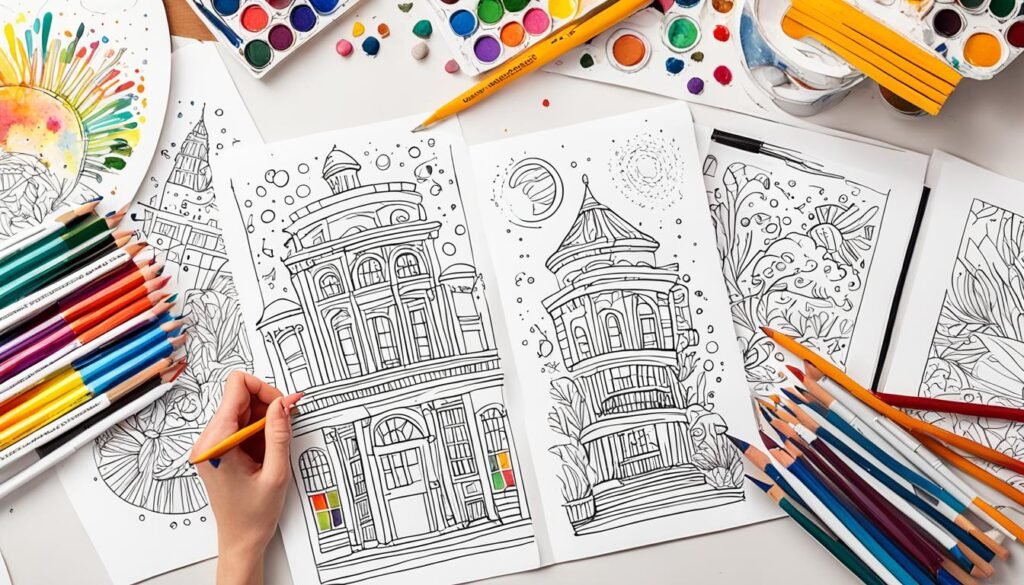
Setting the Theme: Unleashing Your Creativity
Embarking on the journey of creating your own coloring book is akin to setting off on a grand adventure where the landscape is borne of your imagination. The theme of your coloring book is not just a framing device; it is the heartbeat of your enterprise, the narrative that will captivate the colorist’s mind. Whether you draw from the delicate patterns of nature, the sumptuous visuals of gastronomy, or the boundless realms of abstraction, your theme is a reflection of your creative essence.
Finding Inspiration for Book Themes
In the quest for tips for making a homemade coloring book, looking for inspiration can be as simple as observing the world around you or diving deep into the realms of your favorite stories. Each artist’s inspiration is uniquely their own—some may find themselves drawn to the geometric intricacies of mandalas, while others may be inspired by the flora and fauna of their local park. The beauty of creating your own coloring book is the freedom it affords; every page is a blank canvas awaiting the thematic signature you choose to imprint.
Why a Cohesive Theme Matters
A cohesive theme does more than string together a collection of images; it serves as a guide for the colorist, offering a journey rather than just a destination. A well-defined theme adds depth and context to the coloring experience, inviting individuals to not just fill in colors but to immerse themselves in the story your book tells. When making a coloring book from start to finish, a unified theme provides a flow that can transform a simple coloring activity into a narrative exploration.
As the creator, the theme you set can begin modestly with a handful of pages, each one offering a window into the world you’ve crafted. Over time, as confidence and skill grow, so too can the breadth and complexity of your themes. From the understated elegance of a single-color focus to the lavish diversity of a full-scale operatic tapestry, your thematic choices set the stage for a coloring book that can be cherished both as a work of art and a source of personal satisfaction.
| Theme Category | Ideas to Explore | Creator Tips |
|---|---|---|
| Nature | Forests, oceans, wildlife | Use real-life references for authenticity and detail. |
| Cuisine | World foods, desserts, fruit | Think about textures and patterns that invite color variation. |
| Abstract | Geometrical shapes, mandalas | Balance complexity and space to cater to different skill levels. |
| Vintage | Art Deco, retro patterns | Incorporate historical elements to provide depth. |
So ignite the spark of creativity and let your thematic vision guide you in crafting a unique coloring book that stands apart. Embrace the process of discovery as you define and refine your theme, ready to enkindle the imaginations of eager colorists waiting to breathe life into your designs.
Selecting the Right Materials and Tools
Making a coloring book from start to finish involves precise choices in materials and tools to ensure a final product that not only looks professional but entices art enthusiasts into hours of creative coloring. The right selection can elevate a beginner’s guide to coloring book creation into a successful creative project.
Choosing Paper and Printing Options
Paper selection is foundational in the creation of a coloring book. The paper must accommodate the medium your audience will use. Markers, known for their tendency to bleed, necessitate a thicker, possibly coated paper to prevent the colors from ruining other pages. On the other hand, colored pencils and crayons can work well with standard paper. Consider if your coloring book will allow for double-sided pages or if single-sided pages are more suitable.
The Best Tools for Drawing and Inking
The clarity of your coloring book’s images relies heavily on the quality of tools used for drawing and inking. When imbuing intricate details into your work, large-tip pens or bold markers can provide the robust lines needed for vivid black and white imagery. For those embracing digital advancements, graphic tablets and stylus pens offer precision and ease for digital creations. Remember, the choice of tool is crucial in ensuring the spaces within your art are conducive to the desired coloring mediums.
| Tool | Best Used For | Tips for Selection |
|---|---|---|
| Thick Paper (Cardstock, Bristol) | Marker Coloring | Choose weight above 200gsm to prevent bleed-through |
| Standard Paper | Colored Pencils, Crayons | Opt for light-grain textures that are eraser-friendly |
| Large-tip Pens | Bold Lines, Outlining | Confirm ink is archival-quality for longevity |
| Digital Tools (Tablets, Software) | Detailed Designs, Easy Edits | Invest in high-resolution capabilities for crisp printing |
Equipped with the appropriate materials and tools, crafting your custom coloring book becomes a venture both enjoyable and satisfying, making the path from concept to reality smooth for you and rewarding for your coloring book’s future artists.
Designing Your Coloring Book Pages
In your diy coloring book guide, one of the most thrilling stages is designing the pages that will invite hours of coloring bliss. Crafting each black and white illustration with care ensures that your coloring book stands out as a true reflection of your creative vision. Follow this step by step coloring book tutorial for designing pages that delight and engage colorists of all ages.
Starting with a sketch allows you the flexibility to refine and experiment with layouts and details. Once you’re pleased with the arrangement, you’ll graduate to inking. Here, contrast is king; bold, clean lines are the hallmarks of great coloring pages, allowing colorists to easily navigate your designs. Whether creating a whimsical world or an intricate pattern, your drawings must be sharp and high-contrast to suit the coloring medium your audience will use.
Individual attention to each page is critical — crafting them one by one ensures each illustration is given the care it deserves. For those coloring books that tell a story or follow a particular sequence, including page numbers can be incredibly helpful for maintaining the intended order.
Upon completion, your pages are ready for digitization. Scanning your work transforms your physical art into a digital file ready for printing. This final preparation step is a bridge between the handmade and the shareable, an art form in itself that your step by step coloring book tutorial helps to demystify. Whether you’re an experienced artist or a newcomer to the world of DIY crafts, designing your coloring book pages is a fulfilling process that yields a product ripe for the joy of coloring.

- Begin with sketches to map out your ideas and composition.
- Proceed with inking using high-quality pens to achieve a bold, clean look suitable for coloring.
- Work on pages individually to maintain intricate detail and quality in every image.
- If needed, assign page numbers to facilitate proper sequencing and organization in the final coloring book.
- Scan each completed page, ensuring the digital versions are ready for an equally high-quality print product.
With these steps in mind, and this trusty diy coloring book guide at hand, you’re poised to produce a coloring book that combines artistic integrity with coloring accessibility, making every page a potential canvas for someone’s coloring journey.
Digital Design Tips: From Concept to Printable Pages
The coloring book design process has been revolutionized by the advent of digital design tools. In a world where ease and efficiency are paramount, programs like PicMonkey have become invaluable. These tools offer a streamlined approach to creating professional-quality coloring books, from the genesis of an idea to the production of ready-to-print pages. Tapping into the vast potential of digital design can not only accelerate the development of your coloring book but also enhance its aesthetic appeal and marketability.
Utilizing Digital Design Programs for Layouts
Modern coloring book creators harness digital design programs for their powerful layout capabilities. With features that support the generation of blank canvas templates, these programs underpin the layout phase with precision and flexibility. Utilizing a digital canvas, creators can define the boundaries of their designs, ensuring each page adheres to the critical bleed area for a flawless look post-printing. Moreover, multi-page functionality within these programs allows designers to generate numerous pages, up to 30 or more, enabling the crafting of a substantial coloring book in one seamless operation.
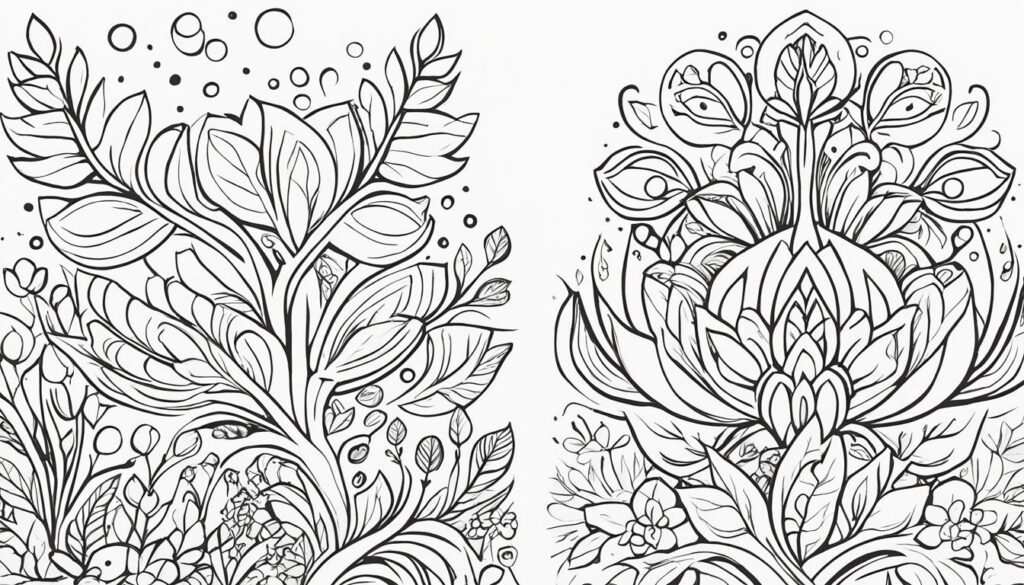
Transforming Illustrations into Digital Format
Transitioning from traditional sketches to a digital format is a crucial step in the coloring book design process. This metamorphosis involves scanning hand-drawn illustrations or converting free-form digital artwork into standardized pages suitable for printing. Techniques for digital conversion often include adjusting midtones and refining lines to guarantee that illustrations are clear and optimized for coloring. Whether utilizing public-domain illustrations or original artworks, the goal is to achieve that coveted crisp line art that beckons color enthusiasts to add their palette of choice.
Overall, the digital tools available today offer coloring book designers an unparalleled ability to bring their visions to life with convenience and the professional polish that customers desire. Leveraging these tools, your creativity is limited only by imagination.
Crafting the Perfect Cover
The final touch to any coloring book is its cover, serving as both the armor for your pages and the inviting facade beckoning artists to delve inside. In designing a custom coloring book, the cover stands as a defining foreword, speaking volumes about the creativity and wonders housed within its pages. It’s not merely a protective layer but a promise of the immersion that awaits, making cover design an art form in itself.
Design Elements of an Attractive Cover
An attractive cover is more than aesthetics; it’s a strategic confluence of elements that come together to make a statement. The use of color, typography, and imagery must reflect the thematic core of your book, suggesting the contents in a way that’s visually compelling and emotionally engaging. High-quality illustrations that hint at the style and scope of the pages inside are essential in crafting a cover that doesn’t just protect but projects the ethos of your coloring book.
Incorporating Visual Previews on Your Cover
One of the most effective strategies in piquing interest is to incorporate a visual preview of your coloring book’s content into the cover design. You may feature a signature illustration, which can either be undeniably intricate or charmingly simplistic, setting the right expectations and level of challenge for your users. Whether fully rendered in vivid hues or left in its original black-and-white line form, this glimpse lays out an open invitation for potential colorists to engage with your work.
In the realm of designing a custom coloring book, remember that the cover serves as your silent ambassador, enticing coloring enthusiasts into the microcosm you’ve intricately pieced together page by page. Through thoughtful design and visual storytelling, your cover can do much of the initial allure that will translate into hours of satisfaction and colorful exploration for its owner.
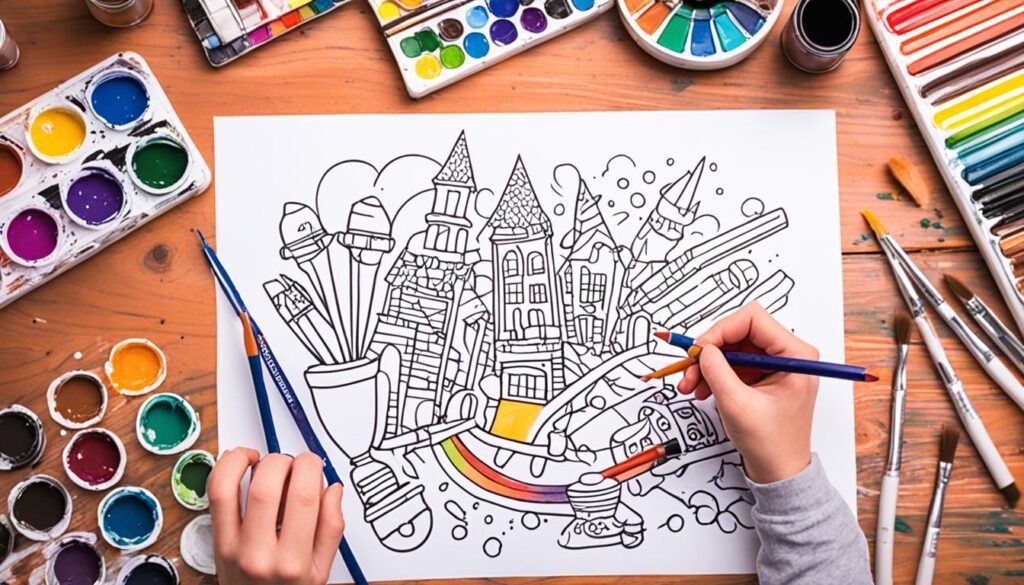
Binding Techniques: Piecing Together Your Masterpiece
Having created your pages, the grand finale in how to create a coloring book from scratch involves combining the pages into a tangible book. This is where binding comes into play, encapsulating your craft and setting the stage for your audience’s coloring exploration. Whether you’re seeking a handcrafted essence or a sleek, professional look, understanding the various binding options will enhance the final presentation of your creative undertaking.
DIY Binding Solutions for a Handcrafted Look
For those who delight in adding a personal touch, DIY binding methods are a testament to the charm of handmade items. Crafting aficionados will appreciate the nuance that simple, yet intimate, binding solutions can bring to their coloring books. Step by step coloring book tutorials often emphasize the appeal of threading together your pages using a needle and thread. This approach not only allows for a customizable book spine but also imparts a sense of authenticity and craftsmanship to each copy.
Another popular DIY method is the use of staples or rivets, which facilitate a faster binding process while still keeping that personal, crafted feel. With just a few staples down the centerline or corners, you can turn your series of illustrations into a flip-through wonder. Keep in mind, for thicker collections of pages, saddle stitch binding could be the way to go, providing a neat and durable edge to your book.
Professional Binding Options for a Polished Finish
If durability and a refined appearance are what you seek, professional binding services elevate your coloring book to a level of sophistication suitable for retail shelves. Employing a service that specializes in bookbinding can offer a spectrum of choices like perfect binding, where adhesive is applied to the spine for a clean, flat look. For coloring books with a heavier page count, coil binding or spiral binding can be practical, allowing for easy page turns and flat lay open, creating a seamless coloring experience.
When exploring professional binding options, consider the user’s experience and the type of coloring book you’ve created. For instance, hardcover binding is ideal for a luxury edition, while wire-o binding suits those seeking both beauty and function. It’s a balance between aesthetic and practicality that defines the best approach for your project.
Ultimately, the way you bind your coloring book can add to the allure, beckon users to indulge in the experience you’ve crafted, and protect your pages as they become treasured pieces of art. From the personal flair of do-it-yourself techniques to the sleek sophistication of professional services, your binding choice solidifies your coloring book as a cohesive and finished masterpiece.
Conclusion
A culmination of creativity and mindfulness, the creation of a coloring book is a journey sprinkled with personal touches and intricate designs that lead to a rewarding endpoint. As we lift our pens from the final page, it is time to reflect on this artistic adventure—a comprehensive process that starts with a mere concept and evolves into a polished product ready to catalyze relaxation and imagination.
Reflecting on the Coloring Book Design Process
The design process itself is as enriching as the artifacts borne from it. Throughout this journey, from the spark of an initial theme to the final stroke of the binder’s thread, we’re reminded that the beauty lies in the details. Each decision, whether it was about the size, medium, or theme, was a deliberate step towards actualizing a vision. Through these coloring book creation tips, artists and would-be publishers alike are reminded that producing a coloring book is not only about the end product but also the joy found in its conception and development.
Sharing Your Coloring Book with the World
Once your masterpiece is complete, the next gratifying phase is sharing your coloring book. Whether it becomes a cherished personal collection, a thoughtful gift, or a product for others to purchase, the act of distributing your creation is a profound moment of connection. Each page shared carries with it the story of its creation, ready to enchant a plethora of artists, both young and old, as they infuse it with their choice of hues. Let the experience of sharing your coloring book serve as an impetus to continue crafting, inspiring, and bridging worlds through the power of creativity.
FAQ
What are the benefits of creating my own coloring book?
Creating your own coloring book allows for personal artistic expression and can be a therapeutic activity that promotes stress relief and mindfulness practice. It also presents an opportunity to produce a unique product for others to enjoy.
What initial factors should I consider when making a coloring book from scratch?
Deciding on the size and alignment are your first steps, along with considering the coloring mediums to determine if you need single-sided or double-sided printing, and the right paper type to prevent bleed-through.
How do I decide on a theme for my coloring book?
Look for inspiration in your interests, such as nature, patterns, or cultural motifs. A cohesive theme not only appeals to a specific audience but also brings a structured and focused approach to your book.
What materials and tools are best for creating a coloring book?
High-quality, thick paper is ideal for preventing bleed-through. For drawing, precise tools like fine-liners or brushes, and digital software are great for creating clean, sharp lines.
How do I design pages for my coloring book?
Start by sketching out your designs, considering balance and composition. Once satisfied, ink your sketches with bold, clear lines. Each design should be scanned at a high resolution to ensure print quality.
Which digital design programs are recommended for making a coloring book?
Programs like Adobe Illustrator, CorelDRAW, or PicMonkey are popular choices for creating digital layouts and transforming images into coloring book pages.
How can I transform existing illustrations into digital format suitable for a coloring book?
Illustrations can be converted into line art using digital tools that remove shading and create clear outlines, which makes them ready for coloring.
What should I consider when designing the cover for my coloring book?
Your cover should reflect the theme and content of your book. It can feature a colored or line art version of one of your interior designs, enticing potential colorists with a visual preview of what’s inside.
What binding options are available for DIY coloring book creators?
For a handmade touch, simple stitching techniques can be used, or for a polished look, spiral or saddle-stitch binding services can be employed.
How can I share my finished coloring book with others?
You can sell your coloring book online through platforms like Etsy or at local craft markets. You could also gift it to friends and family or use it as a portfolio piece if you’re an aspiring artist.

